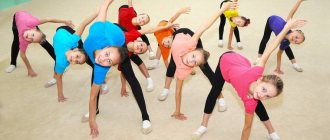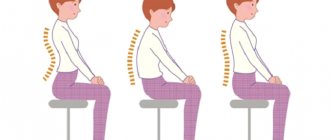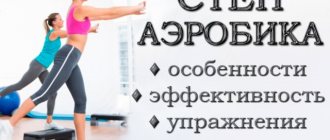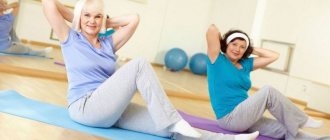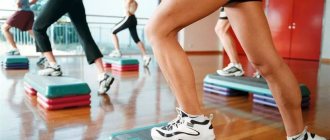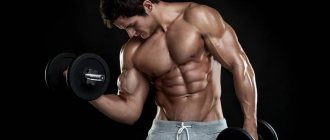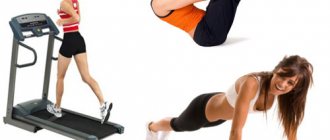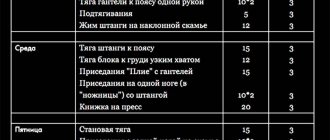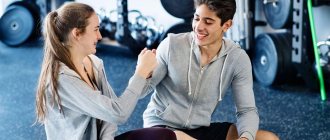Most people think that aerobics is a sport for women aimed at losing weight. A picture of group exercises in the gym or energetic movements at home in front of the TV appears before your eyes.
But this is far from true. This sport can be practiced by everyone, including children. This is very beneficial for the health and harmonious development of the child. In essence, children's classes are similar to adult fitness, only in a simplified and abbreviated form.
The exercises are diluted with dancing to cheerful music, as well as game elements. This sport is suitable for children of any age.
There are no special restrictions for classes. Even if you have any chronic diseases, such as asthma or other pulmonary diseases, you can choose a special program with a light load.
Contraindications can only be injuries, serious diseases of the heart, respiratory system, spine, etc.
Dance aerobics
For those who want to develop a child’s musicality, hearing, sense of rhythm and plasticity, as well as strengthen the muscles of the body as a whole, dance aerobics for children is suitable.
In addition, it improves memory and attentiveness, since it is necessary to remember dance movements.
Typically, a lesson is divided into three parts: warm-up, main part and cool-down.
Sports aerobics
This is a more difficult type of aerobics. It is better to bring children five to six years old to such classes.
Sports aerobics for children includes many elements from gymnastics, but without acrobatics.
Trains strength and endurance. Develops the vestibular apparatus, the ability to control one’s body, and forms a strong muscle corset.
Types of children's aerobics
Experts offer several types of aerobics, adapted specifically for children:
- animal aerobics: in it all movements are similar to the movements of animals;
- Logo-aerobics: its peculiarity is the simultaneous performance of exercises and reading quatrains, pronunciation of sounds;
- step aerobics: this type is similar to adults, but individual equipment is used; for example, in a step dance, the height of the steps is no more than 8 cm, their width and length are, respectively, 25 and 40 cm; in addition, the equipment is covered with leatherette, and the classes themselves are conducted to upbeat music;
- football aerobics: classes are conducted using special balls;
- yoga: exercises only those that are designed for a child’s body;
- dance aerobics: all movements are performed in dance;
- power aerobics.
Children's dance aerobics
This type of aerobics is based on dance movements inherent in different dance styles. At the same time, they are combined with aerobic exercises that children in a certain age group can perform. These classes are perhaps the most exciting for children of all the methods of health-improving gymnastics.
Aerobic exercise is any type of physical exercise of relatively low intensity, where oxygen is used as the main source of energy to support muscle motor activity. (Wikipedia)
By doing dance aerobics, children develop harmoniously physically and mentally. Their coordination of movements improves faster and their endurance increases. They become, for the most part, followers of a healthy, active, balanced lifestyle in the future.
At a dance aerobics class
Dance aerobics classes last approximately one hour. This time includes:
- 10-minute warm-up;
- 40-minute aerobic dances: they combine aerobic exercises and dance steps, games, choreographic elements; all this is done to the accompaniment of children's songs;
- 10 min. stretching and relaxation: during this time, the child’s body recovers from the stress to which it was previously exposed.
Step aerobics for children
This type of aerobics is different for different age groups of children. This is understandable, because they develop very quickly, various significant changes occur in their body, in the skeleton, etc.
This type of aerobics uses a special platform called a step. For children, its dimensions are somewhat reduced: height is reduced to 8 cm, width to 25 cm, length to 40 cm. The meaning of the lessons revolves around the steps that children take from the floor to the platform and back.
Step aerobics classes in kindergarten
Usually children do step aerobics with great interest. Classes allow them to quickly learn how to balance. They become self-confident, more resilient, begin to better navigate space, and make more accurate movements. They naturally develop strength, agility, and speed.
When developing a step aerobics complex, the characteristics of the children in the group and their physical fitness are usually taken into account. Wherein:
- select exercises that suit them;
- distribute the exercises so as to evenly load the body during the entire workout;
- plan a gradual increase in the volume of exercises, their intensity and the load that children receive while performing them;
- They select music that will accompany the classes, making them more emotional and interesting.
According to current practice, step aerobics classes are conducted in different forms. For example, in kindergartens it is:
- classes lasting 25...35 minutes, characterized by a health-improving and training character;
- part of some activities; in this case, the time allocated for step aerobics is 10...14 minutes;
- morning exercises;
- demonstration performances that children perform at holidays;
- entertainment.
Typically, one set of step aerobics exercises is performed for no more than three months. But it is constantly updated with new exercises and becomes more complicated. Later, the children move on to the next complex. In this case, the load is monitored by pulse rate, which should not exceed 150...160 beats/min.
The rules of sports aerobics recommend:
- when stepping onto the platform, load your legs, not your back;
- place the foot on the platform completely, with the entire sole;
- do not make sudden movements;
- Do not work for more than a minute with one leg or arm.
#sports aerobics for children
This type of aerobics is radically different from all other types. This is already part of gymnastics; although it is young, it is already considered a popular sport. In the future, it may be included in the Olympic Games program.
Sports aerobics includes exercises that are typical for gymnasts. The only difference is that they do not contain complex gymnastic and acrobatic elements. They are performed quickly, at a certain pace, with mandatory musical accompaniment.
At a sports aerobics training session at the MultiSport children's fitness club in Luzhniki
Children begin to engage in sports aerobics no earlier than 5 years old. Before admission to the sections, their flexibility, strength, and plasticity are determined. If they are enrolled in a group, they must attend classes three times a week. Over time, of course, both the frequency of classes and their intensity increase.
When doing aerobics you need to wear certain shoes and clothing. Czech shoes are better; from clothes: for girls - swimsuit; for boys - T-shirt, shorts.
Sports aerobics allows children to become stronger, more flexible, and more flexible. Girls who practice it acquire graceful movements and beautiful posture. Boys will be able to master their body perfectly, they will become strong and maintain good physical fitness for many years.
Step aerobics aerobics
As in adult classes, this type of exercise uses a step platform, but it is smaller in size - about 10 centimeters in height. Includes a set of various steps and jumps.
Teaches you to be agile, fast and attentive, and to keep your balance well. Trains the cardiovascular system.
The benefits of aerobics for children
The key advantage of aerobics for a growing body is its positive effect on psychomotor skills. Physical development is combined with the formation of coordination of movements and the ability to control one’s body, and increased activity.
The benefits of a set of aerobic exercises for a growing body:
- Learning the ability to take steps and repetitions in a certain rhythm, to be attentive.
- Improving the functioning of all systems of the child’s body, especially the musculoskeletal, cardiovascular, respiratory, nervous, and immune systems.
- Socialization, namely, the opportunity to meet other children and communicate in a group.
- Increased strength and dexterity of movements, the ability to perceive space.
- Prevention of physical inactivity, obesity, colds, flat feet.
- Building self-confidence in communicating with children and adults.
- Normalization of metabolism.
- Increased endurance.
- Strengthening your posture.
The primary importance of aerobics is to strengthen the skeleton and muscles. For teenagers, these types of exercises are important to develop flexibility and strength, and improve their figure. Classes help develop self-control, endurance, and determination.
Aerobics in preschool age additionally acts as a “lightning rod” for excessive physical activity. Classes help reduce aggressiveness, which is a consequence of the stress experienced by the child in the children's team.
Rhythmic movements to music are a useful alternative to sitting at the computer or in front of the TV. The child spends more time with peers and learns to make friends. Aerobics distracts from the yard company, which often corrupts children.
You can exercise outside, which is especially important for relieving mental and emotional stress. Physical activity and fresh air are double benefits for the body.
Babies 1-1.5 years old
You can start training as early as a year and a half. Even for such little ones, this is very useful, since physical development is closely related to intellectual development.
Of course, for such kids the exercises will be the simplest and take little time. About ten minutes is enough for children.
Often such fitness breaks are included in the program of general developmental activities for children in order to change the type of activity and not overstay their welcome.
The lesson is always held in a playful way, using various paraphernalia, such as balls, rings, fabric tunnels, orthopedic mats, various toys, etc.
The movements are simple - running, squats, various steps, crawling. These workouts allow you to get active and have fun.
Children 3-5 years old
For older children, classes become more difficult. They are also built in the form of a game, since at this age children are very active and energetic.
The game form is aimed at making it interesting, but at the same time performs the function of physical development.
In addition, it helps to slightly restrain the activity of the kids and spend their energy usefully. The child learns to control himself and focus his attention.
Exercises for children's aerobics of this age consist of squats, jumps, elements lying on the floor, and dance movements.
A variety of equipment is also used - hoops, benches, ladders, cubes and balls, special sticks, and so on.
The muscles are actively involved in work, flexibility and coordination develop, and flat feet are prevented.
The duration of such lessons is about 20-30 minutes, no more, twice a week.
FITNESS AEROBICS PROGRAM (FOR GIRLS)
Topic 42-53. Step aerobics Introduction to traumatic exercises on the step platform. Familiarization with various approaches to the step platform. Basic starting positions. Mastering the technique of basic steps in step aerobics classes.
- Basic Step. With a right step, stand on the platform, place the left one, with a right step, step off the platform and return to the position. Performed on 4 counts. Same thing on the other leg
- Step legs apart - legs together (V-Step) - performed in the same way as in classical aerobics.
- An additional step (Tap Up, Tap Down) touching the platform and the floor at the top and bottom. With your right step, stand on the platform, straightening your knee, place your left foot on your toes, without bearing the weight of your body, step off the platform with your left, and place your right foot on your toes to the supporting one. Performed on 4 counts. The same with the other leg.
- Added step with touch on the platform for 8 counts (Tap Up). Performed with a change of leg. Step with your right to stand on the platform, place your left against your right, without bearing the weight of your body, step with your left back, place your right against your left. The same with the other leg.
- An additional step with a change of foot with a touch at the bottom for 8 counts (Tap Down). Step onto the platform with your right hand, place your left hand next to your right, the weight of the body is transferred to two legs. With your right step, step back from the platform, place your left hand on your half-toes, without transferring the weight of your body to it. Step onto the platform with your left, place your right one, step with your left back and get off the platform. It is possible to perform the exercise with the left leg. Approach when performing: from the front, from the end, from above.
- Touching the platform with the toe of the free foot or the entire foot (Step Tap). Bending your right leg, touch the platform with your foot (toe), place it on the left, return to the i.p. Same with the other leg. Performed on 2 counts.
- Steps with rising onto the platform and bending the leg forward (Knee up). The exercise is performed in the same way as in classical aerobics.
- Steps with lifting onto the platform and swinging the other forward (Lift Front), to the side (Side), back (Back).
- Steps up onto a platform with the leg bent back (Leg Curl).
- Lifting onto the platform with a Kick of the free leg.
- Steps feet together, feet apart (Straddle Up). From i.p. stand with legs apart (step between legs) - step with the right one onto the platform, place the left one, simultaneously straightening the legs. Alternately step off the platform with your right and left feet. The movement is performed in 4 counts. The approach is performed in a longitudinal position relative to the platform.
- The same as in ex. 11, but executed from OS. on the platform (Straddle Down).
- Turn Step. I.p. - stand sideways to the platform. Step left onto the platform, place the right one with your back turned to the main direction (lengthwise to the platform), stand with your legs apart. Step back with your right hand, turning diagonally, step with your right back from the platform, place your left hand, return to IP. The same with the other leg. Approach when performing: in a diagonal direction from the corner of the platform.
- Step over the platform (Over the Top). From a standing position sideways to the platform (longitudinally), step with your right side to the side, stand on the platform, place your left one, step off the platform with your right hand (on the other side), place your left one. The same with the other leg. Approach when performing: from the side in a longitudinal stance relative to the platform.
- Steps in a diagonal direction from corner to corner of the platform (Corner to Corner).
- Steps across the platform in the longitudinal direction (Across).
- Cross-step across platforms.
- Lunges to the side and back. They are performed in a longitudinal or transverse position to the platform. The technical requirements for performance are the same as in classical aerobics: do not lower the heel to the floor. Approach when performing: from above. Options: repeated execution on one leg; execution with a change of leg.
- Side steps - feet together, feet apart (T-Step). From the crossbar at the end of the platform, step forward with your right, place your left (on the platform), step with your right to the right, then with your left to the left. Take a position with your feet apart (step between your legs). The same in the opposite direction. Performed on 8 counts. The same with the other leg. Approach when performing: from the end and on both sides of the platform.
- Angle steps (L-Step). Standing at the end of the platform in the longitudinal direction - step right, then left onto the platform. Take a right step to the side. Get off the platform and place the left one against the right one. Performed on 4 counts. The same with the left leg from the other end of the platform. Approach when performing: from the front and from the end.
- U-Step. The same as in ex. 9, but with little progress. Approach when performing: from the side, from the end.
- Step with a 90° turn, bending the leg forward and jumping on the supporting leg (1/4 Hop Turn). Standing on two legs at the third part of the platform (longitudinal). Step onto the platform with your right hand, bending your left hand forward and turn to the right. Step left backwards off the platform, placing your right hand next to your left. Performed on 4 counts. The same with the other leg from the other third of the platform. Approach when performing: from the side, from the edge, from the corner, from the sides (final position - legs apart). Options: from i.p. - standing diagonally from the edge of the platform; with a 180° turn with a different approach (Hop Turn).
- A-Step. Stand facing the platform at the edge in the longitudinal direction. Step the right one into the center of the platform, place the left one against the right one, take a step with the right one back diagonally. Get off the platform and place the left one against the right one. Performed on 4 counts. The same with the other leg. Approach when performing: from the front, from the end.
- The same as in ex. 23, but with a jump: A. Leap 1 - jump onto the platform with one foot, plant the other, step off the platform. B. Leap 2 - jump onto the platform. After stepping on the second count, step off the platform. C. Run-Run - a combination of elements of exercises A and B (Double leap). D. Hop step followed by a hop.
- Jumping. Performed by pushing with two legs and landing on two legs, or with one leg and landing on two legs on a platform.
Approximate hand positions and movements
- Hands on the belt.
- Flexion - extension of the arms at the elbow joints.
- Flexion - extension of the arms in the frontal plane (“rowing”).
- Reduction - spreading the arms.
- Flexion - extension of the arms to the sides.
- Hands on the waist, punch in a diagonal position.
Topic 54-65. Fitball aerobics Mastering the technique of basic steps of fitball aerobics:
- Added step ( step - touch ). IP - sitting on a fitball, legs together, knees over feet, the angle between the torso, hips and knees is 90-100 degrees. Additional steps to the side, in a square, with a turn to the right, left, in a circle;
- Step - touch ( touch - step ). IP - the same, moving the leg to the side (forward) - on the toe;
- March ( march ). IP - the same, walking in place with moving forward, backward, diagonally, walking with a spring movement. Walking with a turn to the right (left), in a circle, a full circle;
- Twist . _ IP - the same, jumping on two legs with twisting of the hips;
- Jump legs apart and together ( jumping - jach ). I.p. - the same, jump legs apart and together;
- Lunge ( lange ). IP - the same, lunges forward, to the side, backward, diagonally. One leg moves forward, the other back. The weight of the body is distributed equally on both legs;
- Swing your legs ( kick ). IP - the same, bending the leg forward, to the side, diagonally, raising the knee at the horizontal level or higher;
- Raising the knee up ( kneeup , kneelift ). Bend the leg forward, to the side, diagonally, raising the knee to the horizontal level or higher.
Fitball-gymnastics complex No. 1:
- Bridge on the ball IP: sitting with your back to the ball 1 -2-3-4 rolls
- Torso turns I..l: standing on your knees, hands on the ball 1-turn the body to the left, taking one hand down 2nd p. 3-turn the body to the right 4-p.
- Tilts I.p.: sitting on the ball, legs apart 1-2-3 tilt to the left leg 4-i.p. 5-6-7 tilt to the right leg 8-ip.
- Rolling the ball IP: lying on the floor, feet on the ball 1 -2-3 rolling the ball towards you 4-IP.
- Somersault I.p.: lying on the ball with your stomach 1 -2-3-4 roll forward with a flip over your head
- Dive IP: squat at the ball 1 -2 roll forward bending arms 3-4 IP.
Fitball-gymnastics complex No. 2
- I.p.: sit on the ball, arms forward, smooth movements of the arms up to the sides in a circle. Bend the torso to the sides with the movement of the arms. Bend forward, bending down, back.
- I.p.: lying on the stomach 1-3 - balance in a deflection 4-I.p.
- I.p.: the same 1-4 - rolls forward with a point-blank position on bent arms 5-8-I. P.
- I.p. : also 1-2-roll forward 3-swing right 4-I.p. Same with the other leg
- I.p.: lying sideways on the ball with support on the right hand 1 -2- swing with the left leg to the left 3-4-I.p. Same with the other leg
- IP: the same. Swing back and forth
- I.p.: lying on your back with the support of your arms Rolling back and forth in a deflection
- I.p.: sitting with your back to the ball, alternately swing your legs up
- I.p.: lying on your back, grabbing the ball with your feet. 1-4-roll back, raising the ball above your head 5-8-roll in I.p. Try not to lose the ball
- I.p.: o.s. the ball is at your feet. Raise the ball up, stretch and bend into the I.p.
Topic 66-77. Dance aerobics Mastering a wide range of dance techniques - fandance, hip-hop and Latin. Mastering the technique of basic basic dance steps:
- Step forward, backward - step the right (left) forward, the left (right) is placed next to the right (left), but the feet remain at a distance. The peculiarity of the technique is small spring movements with the legs;
- Steps to the side - step the right (left) to the side, the left (right) is placed with the weight of the body transferred to it, repeated execution in one direction is possible, with a change in direction, with a half-squat, with springing the knees inward - outward;
- Jumping forward - backward - performed in steps and jumps: right forward, return to the left foot back, put the right foot to the left, similarly with the other foot;
- “Touch” to the side - step with the right foot to the side (with legs apart), place the right foot next to the left, and do the same with the other foot (in the other direction);
- “Touch” back and forth - placing the right foot forward on the toe (or heel), placing the right foot next to the left, transferring the weight of the body to it, placing the left foot back on the toe;
- Sliding steps - performed on the spot with movement forward, backward, with a turn;
- “Kick” - swing forward, to the side, back;
- Jumping on two legs - a vertical jump with a push of two and landing on two;
- Jumping in lunges - step right (left) forward, jump with a push with two, change the position of the legs - left (right) forward and land on two legs;
- Jump legs apart, legs together - 1- jump legs apart and jump legs together; 2- pause;
- Jump legs apart, legs crossed - the movement is similar to the previous one, but ends in a crossed stance, right or left in front;
- Jump with legs bent - performed with a push of two with landing in a standing position with legs apart, with some “pulling”, fixing the position of the legs in a tuck during the flight phase and quickly spreading the legs before landing. Learning combinations, blocks and programs using basic dance style movements. Mastering the principle of contrast, using elements in a standing position, jumps in combination with ground elements. Familiarization with ground exercises characteristic of fandance and hip-hop styles.
Topic 78-89. Strength aerobics Mastering the technique of strength training in aerobics classes, which discusses the importance of strength training for healing, improving physique, general physiological information on the theory of muscle contraction, anatomical principle, and also based on the laws of kinesiology:
- exercises for the muscles of the foot and lower leg;
- exercises for the muscles of the anterior thigh;
- exercises for the back of the thigh;
- exercises for the adductor muscles of the thigh;
- exercises for the adductor, abductor muscles of the thigh and pelvic muscles;
- exercises for hip extensors;
- exercises for the muscles of the thigh, pelvis, back;
- exercises for the rectus abdominis muscles;
- exercises for back muscles;
- exercises for the back, shoulder girdle, arms;
- exercises for the muscles of the chest, shoulder girdle, arms.
Mastering exercises with rubber shock absorbers, expanders, dumbbells and exercise machines.
Topic 90-95. Shaping with dumbbells Set of exercises No. 1
1. I.p.: basic dumbbell stance to the shoulders 1.2. dumbbells forward 3.4 - dumbbells to the sides 5.6 - dumbbells up 7.8 - i.p. 2. I.p. - basic dumbbell stance on the waist, 1-2 - head movements in a circle around the dumbbell in front of the chest, 3-4 - in the other direction. 3. I.p. - dumbbells in front of the chest, jerks with arms to the sides 4. I.p. - o.s., dumbbells forward. Squats. 5. I.p. - the same, bending the dumbbells upward to the sides 6. I.p. - sh.s. jumping. 7. IP - walking with breathing restored. 8. I.p. - o.s., circular movements of the body 9 - 10. I.p. - the same, bends 11. I.p. - the same, lunges forward, dumbbells to the sides 12. I.p. - stand with your legs apart, swing your leg with lunges 13-14. Jumping, walking 15-20. Exercises in the saddle 21-30. Exercises in a lying position.
Set of exercises No. 2 1. I.p.: basic dumbbell stance to the shoulders 1.2. - dumbbells forward 3.4 - dumbbells to the sides 5.6 - dumbbells up 7.8-ip 2. I.p. - o.s., dumbbells in front of the chest. jerks with bent arms to the sides - back. 3. I.p - sh.s., dumbbells up. Circular movements of the body to the right and to the left. 4. I.p. - Same . Bend forward. 5. I.p. - the same with turns to the right and left. 6. I.p. - narrow stand. Squats, dumbbells forward. 7. I.p. - Same. Squats and bends. 8. I.p. - standing at the support. Swing with bent legs, dumbbells on the knee. Same with straight legs. 9. I.p. - emphasis while standing at a support. Shifting from foot to foot. 10. Jumping on two. Walking. 11-15. Exercises while sitting. Bends, on the abs, on the back. 16. I.p. — gray legs apart. Deep bends forward, dumbbells behind the head. 17. I.p. - lunge forward with the right hand, dumbbells on the knee. Springy swaying with the transition to the other leg. 18. I.p. - half-split. Bend back, dumbbells up. 19. I.p. - lowering into a split with the help of a partner. 20. Hanging on the bar - stretching the spine. 30sec. — 2 minutes (maximum). 21 - 25. Exercises on strength training equipment.
Topic 96-101 . Stretching with yoga elements Introducing the basic yoga asanas - in a standing position (mountain pose, tree pose, elongated triangle pose, warrior pose, Tadasana pose, bending forward, legs together, arms parallel to the floor, bending forward in a standing position , legs apart, right (left) in front, arms in front or back, “eagle” pose, “power” pose); - in a sitting position ("easy" pose - sitting with crossed legs, "lotus" pose, "hero" pose, "cow's head" pose, "mountain" pose, "staff" pose, in a sitting position with straight legs, bending forward, bending with the index and middle fingers grasping the big toes, bending forward with the legs apart, arms forward or to the side, bending forward, one leg bent, the knee lying on the floor, bending forward with the leg bent back - in a lying position (pose " fish", pose with raised legs, kneeling pose, lying on your back with legs bent back, "cobra" pose, "bow" pose); - with a rotation of the body - twisting (in a standing position with a bend forward, in a sitting position, legs apart, one leg is bent, body turns are performed in a sitting position towards the bent leg, the right leg is bent, turn to the right); - in the position of supports (“dog”, “cat”, emphasis on the feet and forearms, bridge in a lying position). Familiarization with relaxation and meditation.
Topic 102. Final lesson. Diagnostics at the end of the year.
SCHEDULE PLANNING
| № | Topic of the training session | Number of hours | date |
| 1 | Rules of conduct and safety precautions in the classroom. | 1 | |
| 2 | Diagnostics | 1 | |
| 3 | Exercises to develop correct posture | 1 | |
| 4 | Exercises to develop correct posture | 1 | |
| 5 | Exercises to develop correct posture | 1 | |
| 6 | Exercises to develop correct posture | 1 | |
| 7 | Rhythmic gymnastics | 1 | |
| 8 | Rhythmic gymnastics | 1 | |
| 9 | Rhythmic gymnastics | 1 | |
| 10 | Rhythmic gymnastics | 1 | |
| 11 | Exercises to develop flexibility (stretching) | 1 | |
| 12 | Exercises to develop flexibility (stretching) | 1 | |
| 13 | Exercises to develop flexibility (stretching) | 1 | |
| 14 | Exercises to develop flexibility (stretching) | 1 | |
| 15 | Strength exercises for muscles, arms, legs, abs | 1 | |
| 16 | Strength exercises for muscles, arms, legs, abs | 1 | |
| 17 | Strength exercises for muscles, arms, legs, abs | 1 | |
| 18 | Strength exercises for muscles, arms, legs, abs | 1 | |
| 19 | Skipping. Exercises with a jump rope | 1 | |
| 20 | Skipping. Exercises with a jump rope | 1 | |
| 21 | Skipping. Exercises with a jump rope | 1 | |
| 22 | Skipping. Exercises with a jump rope | 1 | |
| 23 | Basic aerobics steps | 1 | |
| 24 | Basic aerobics steps | 1 | |
| 25 | Basic aerobics steps | 1 | |
| 26 | Basic aerobics steps | 1 | |
| 27 | Basic aerobics steps | 1 | |
| 28 | Basic aerobics steps | 1 | |
| 29 | Basic aerobics steps | 1 | |
| 30 | Classic aerobics | 1 | |
| 31 | Classic aerobics | 1 | |
| 32 | Classic aerobics | 1 | |
| 33 | Classic aerobics | 1 | |
| 34 | Classic aerobics | 1 | |
| 35 | Classic aerobics | 1 | |
| 36 | Classic aerobics | 1 | |
| 37 | Classic aerobics | 1 | |
| 38 | Classic aerobics | 1 | |
| 39 | Classic aerobics | 1 | |
| 40 | Classic aerobics | 1 | |
| 41 | Classic aerobics | 1 | |
| 42 | Step aerobics | 1 | |
| 43 | Step aerobics | 1 | |
| 44 | Step aerobics | 1 | |
| 45 | Step aerobics | 1 | |
| 46 | Step aerobics | 1 | |
| 47 | Step aerobics | 1 | |
| 47 | Step aerobics | 1 | |
| 49 | Step aerobics | 1 | |
| 50 | Step aerobics | 1 | |
| 51 | Step aerobics | 1 | |
| 52 | Step aerobics | 1 | |
| 53 | Step aerobics | 1 | |
| 54 | Fitball aerobics | 1 | |
| 55 | Fitball aerobics | 1 | |
| 56 | Fitball aerobics | 1 | |
| 57 | Fitball aerobics | 1 | |
| 58 | Fitball aerobics | 1 | |
| 59 | Fitball aerobics | 1 | |
| 60 | Fitball aerobics | 1 | |
| 61 | Fitball aerobics | 1 | |
| 62 | Fitball aerobics | 1 | |
| 63 | Fitball aerobics | 1 | |
| 64 | Fitball aerobics | 1 | |
| 65 | Fitball aerobics | 1 | |
| 66 | Dance aerobics | 1 | |
| 67 | Dance aerobics | 1 | |
| 68 | Dance aerobics | 1 | |
| 69 | Dance aerobics | 1 | |
| 70 | Dance aerobics | 1 | |
| 71 | Dance aerobics | 1 | |
| 72 | Dance aerobics | 1 | |
| 73 | Dance aerobics | 1 | |
| 74 | Dance aerobics | 1 | |
| 75 | Dance aerobics | 1 | |
| 76 | Dance aerobics | 1 | |
| 77 | Dance aerobics | 1 | |
| 78 | Strength aerobics | 1 | |
| 79 | Strength aerobics | 1 | |
| 80 | Strength aerobics | 1 | |
| 81 | Strength aerobics | 1 | |
| 82 | Strength aerobics | 1 | |
| 83 | Strength aerobics | 1 | |
| 84 | Strength aerobics | 1 | |
| 85 | Strength aerobics | 1 | |
| 86 | Strength aerobics | 1 | |
| 87 | Strength aerobics | 1 | |
| 88 | Strength aerobics | 1 | |
| 89 | Strength aerobics | 1 | |
| 90 | Shaping with dumbbells | 1 | |
| 91 | Shaping with dumbbells | 1 | |
| 92 | Shaping with dumbbells | 1 | |
| 93 | Shaping with dumbbells | 1 | |
| 94 | Shaping with dumbbells | 1 | |
| 95 | Shaping with dumbbells | 1 | |
| 96 | Stretching with yoga elements | 1 | |
| 97 | Stretching with yoga elements | 1 | |
| 98 | Stretching with yoga elements | 1 | |
| 99 | Stretching with yoga elements | 1 | |
| 100 | Stretching with yoga elements | 1 | |
| 101 | Stretching with yoga elements | 1 | |
| 102 | Final lesson. Diagnostics | 1 |
Used Books
- Goodsell Ann Fitness, Step by Step. The world of the book. M.-2001
- Kryuchek “Aerobics: content and methodology of recreational activities.” Olympia PREES, M. 2001
- Lisitskaya T.S. Course of lectures “Methodology of organizing and conducting fitness classes at school” - M.: Pedagogical University “First of September”, 2009.
- Austin Denise "Pilates for You" Medley. Minsk 2004
- Rostova V.A., Stuppkina M.O. “Health aerobics” St. Petersburg “Higher Administrative School”, 2003.
- Strugges Stephen "Practical Yoga". The world of the book. M, 2003.
- Eistvin G., Priza O. “World Standard Figure.” M-2000
...PreviousTo the beginning...
Preschoolers 5-6 years old
Aerobics for preschool children is close to adult programs. The exercises become more complex and more varied.
During training, inclined planes, mats, jump ropes, and fitballs are used. Complex tasks are added, such as somersaults and relay races. Increasing cardio loads.
The duration of aerobics classes for children 5-6 years old is 30-40 minutes 2-3 times a week. They can be diluted with dance elements, but the emphasis is on strengthening muscles and developing physical capabilities.
There are also exercises that develop logic. Children learn to work in a team and interact with each other.
However, the elements of the game remain. This allows you to maintain interest and desire to come to training again.
Schoolchildren 7-11 years old
At this age, children's physical activity decreases because they have to sit in class at school and then do homework while sitting at the table. School physical education lessons are not enough to keep muscles toned and maintain the same metabolism.
These circumstances can even lead to obesity, which negatively affects children's health. At the same time, the body’s need for movement only increases. Children's aerobics would be a great solution.
The training program for primary school age includes quite complex elements - gymnastics, dance, strength.
Balance exercises, various jumps, rotations, and hangs are included. It is possible to use special children's simulators. A trainer must teach you how to use them.
The workout takes on average 40-45 minutes. It should not be monotonous; exercises should be selected at different intensity.
Speed, agility, strength, flexibility develop and all muscles of the body are strengthened.
At 7-11 years old, physical qualities can develop to their maximum, since the nervous system is already quite mature by this age.
Children are emotional and react quickly, which allows them to learn new skills better, more accurately and in a fairly short time.
You can take part in competitions, and victories and prizes give you confidence in your abilities.
What does this type of physical education for children consist of?
There are several sets of exercises used in the children's fitness program for preschoolers. They are as useful as shaping and fitball. Let's pay attention to one of them. we are considering consists of the following stages:
- They stand up straight. Feet should be shoulder-width apart. Next, alternately raise the right and left legs. The raised leg must be bent at the knee and touch the elbow. When lifting your right leg, touch your right hand. Accordingly, when bending the left leg, we touch the left hand. This exercise should be performed at least six times.
- When performing the second exercise, you also need to stand straight. The legs are placed on different sides. In this case, the hands should be placed at the waist. First, the left leg is slightly bent at the knee. The right leg should lightly touch the floor. Then the right leg should be bent at the knee, and the toe of the left foot should touch the floor. It should be repeated 10 times, 5 times in one direction and five in the other.
- The next exercise is performed while lying on your stomach. You need to lie down on the floor. The outstretched arms and legs are simultaneously raised upward. The body should remain in this position for at least 2 seconds. This interesting exercise is repeated up to six times in one lesson.
- Next, you should take a special gymnastic stick in your hands. To perform, you need to stand up straight and straighten up. The gymnastic stick is held below. Then, one by one, you should try to step over it. First with the left foot, and then with the right.
- When performing this exercise, stand straight. The legs are spread apart and the hands are placed on the belt. The execution consists of squatting on your toes. At the same time, the back is straight, arms are extended forward. This lesson should consist of at least 6 such squats.
- The exercise is performed in a lying position. They also lie on the floor, only now on their backs. To be able to do this, you need to bend your knees and clasp them with your hands. The essence of the exercise is to pump back and forth on your back. During pumping, the head must be raised.
- The last exercise that will be addressed is jumping. The child stands straight, legs spread apart. When jumping up, they clap their hands above their heads. It is required to perform at least five jumps at a time.
Teenagers 12-16 years old
The guys have completely matured, they are actively growing, but their muscles cannot keep up with the growth rate. In addition, at this age puberty occurs, all systems in the body begin to work in a new way. Aerobics will help you develop physically and look harmonious.
Now children can control the excitability of the nervous system and concentrate better. During training, the emphasis is on strength, endurance and flexibility, strengthening the muscle corset.
Complex gymnastic elements are added, including acrobatic ones. Work is practiced both independently and in pairs or teams.
It is possible to use adult simulators, but only without axial load. The spine is still immature in a growing body, so exercises like squats and deadlifts are dangerous.
Training should not take more than one hour, 2-3 times a week. They must include a warm-up at the beginning and stretching at the end, as well as cardio training.
A little about the musical accompaniment
Music during training is not just background. It sets the pace, rhythm, invigorates, gives strength and adds a good mood. Therefore, music for children's aerobics plays an important role in the structure of the lesson.
The music is selected by the trainer, based on the age of the group and the type of aerobics. First of all, you need to choose a tempo. The speed of execution of elements depends on this:
- Dance aerobics involves upbeat, cheerful music to which you can dance happily;
- For sports, calmer music is suitable, allowing you to concentrate on doing the exercises;
- It is better to choose musical accompaniment for step aerobics with a clear rhythm and a fairly high tempo.
For small children, the playlist is made up of children's songs, including familiar melodies from cartoons.
There are also special songs with movements for kids, when you need to listen to what is being sung and repeat.
The main thing is that children enjoy music and classes in general and go to the gym with joy.
Benefit
The benefits of aerobics are difficult to overestimate. It has a positive effect on various aspects of a child’s development:
- First of all, it improves physical development - strong muscles, strength and flexibility, a beautiful figure, even posture, absence of flat feet, a healthy back and the musculoskeletal system in general;
- Trains the ability to control your body well, coordination and endurance;
- Helps to spend energy, which children have a lot of, directing it to useful things. Thanks to this, children become more diligent and attentive, sleep well and soundly;
- Heals all body systems - respiratory, cardiovascular, improves metabolism. Eliminates the possible problem of obesity (mainly in schoolchildren who move little, sitting in class, doing homework and spending time on computers and gadgets);
- Strengthens immunity
pros
The benefits of aerobics for children are enormous. With its help, you can accustom kids to an active lifestyle and distract them from the “street” or computers. At the same time, children improve their health, become stronger and communicate with like-minded peers.
Aerobics helps prevent diseases that come with a sedentary lifestyle, such as excess weight or heart problems.
Preschoolers are easily excitable, and sports such as aerobics help direct their activity and excessive energy in the right direction.
Aerobics trains self-control. Older children are ready to handle more complex exercises. Thanks to this, such important qualities as endurance, effort and determination develop.
In terms of health, aerobics covers all important areas of the body:
- strengthens the muscular, skeletal and musculoskeletal systems;
- improves joint function;
- trains the respiratory system;
- increases immunity;
- forms correct posture;
- prevents flat feet due to the work of the muscles of the lower leg and foot and stagnant processes in the body;
- optimizes metabolism;
- improves coordination of movements, strength and endurance to physical activity;
- increases activity and cheerfulness.
Another advantage of aerobics is that it can be done outdoors. Moderate exercise in the fresh air is doubly beneficial.
For school-age children, aerobics helps relieve mental stress after school.
